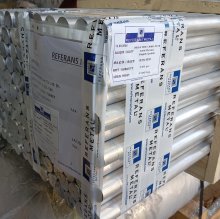




Alliage d aluminium
Cliquez ici pour voir les produits en alliage d'aluminium
.png)
Densité relative
Varie entre 2,7 et 2,9 g/cm³ selon les composants de l’alliage.
Résistance à la corrosion
L’aluminium forme une couche protectrice naturelle à la surface au contact de l’air. Cette couche se reconstitue toujours après avoir été retirée, offrant une résistance exceptionnelle à la corrosion atmosphérique. L’aluminium pur et très pur, ainsi que les alliages sans cuivre, sont résistants à un grand nombre de milieux. Pour cette raison, ils sont largement utilisés dans les industries de la construction et de la chimie, l’industrie agroalimentaire et la construction de véhicules. Cependant, les matériaux à base d’aluminium avec les plus hauts niveaux de résistance — plus de 500 N/mm² — ont une résistance très limitée. Cela doit être compensé par des solutions de conception structurelle.
Propriétés de formage à froid et à chaud
L’aluminium se caractérise par une résistance relativement élevée à la déformation. Toutefois, avec l’utilisation d’installations techniques appropriées, l’aluminium et ses alliages présentent de bonnes à très bonnes propriétés de formage à froid ou à chaud sur un large spectre :
• extrusion
• tréfilage
• moulage
Bon conducteur d’électricité et de chaleur
L’aluminium possède une conductivité électrique élevée (de 38 à environ 34 m/Ohm mm² pour l’aluminium pur). Les matériaux utilisés pour les conducteurs électriques sont principalement l’aluminium pur et les alliages E-AlMgSi. La conductivité thermique, d’environ 80 à 230 W/m·K, est environ quatre fois supérieure à celle du fer.
Propriétés magnétiques
L’aluminium n’est pas magnétique — une propriété importante dans les domaines de l’électrotechnique, de l’électronique et du génie mécanique.
Traitement de surface
Une gamme d’options de traitement de surface est disponible pour l’aluminium, offrant une excellente adaptabilité à pratiquement toutes les applications :
• Anodisation — surfaces décoratives, large gamme de couleurs, surfaces d’équipements techniques — résistantes à l’usure
• Revêtement en poudre dans plusieurs teintes — selon RAL
• Peinture en pulvérisation humide dans plusieurs teintes — selon RAL
• Polissage — mécanique et chimique
• Meulage et brossage, etc.
Haute réflectivité
Les surfaces en aluminium sont naturellement de bons réflecteurs de lumière et de chaleur. Plusieurs traitements de surface peuvent être appliqués pour ajuster les caractéristiques de réflectivité et d’absorption sur une large plage de valeurs.
Techniques d’assemblage
Presque toutes les techniques d’assemblage courantes peuvent être utilisées pour l’aluminium et ses alliages.
Aucun risque pour la santé
Selon les connaissances médicales actuelles, l’aluminium est totalement dépourvu de risques pour la santé.
Recyclabilité
Dans l’industrie, le terme « recyclage » fait spécifiquement référence à la réutilisation des déchets et des produits manufacturés usagés comme matière première secondaire pour la fabrication de nouveaux produits. Plus d’un tiers des matières premières en aluminium utilisées proviennent de processus de recyclage appropriés, sans aucune perte de qualité. Le recyclage ne nécessite que 5 % de l’énergie requise pour la production d’aluminium primaire. Lors du choix entre plusieurs matériaux possibles, l’aluminium est souvent l’option la plus écologique et économique.


 Calculateur de Poids
Calculateur de Poids

